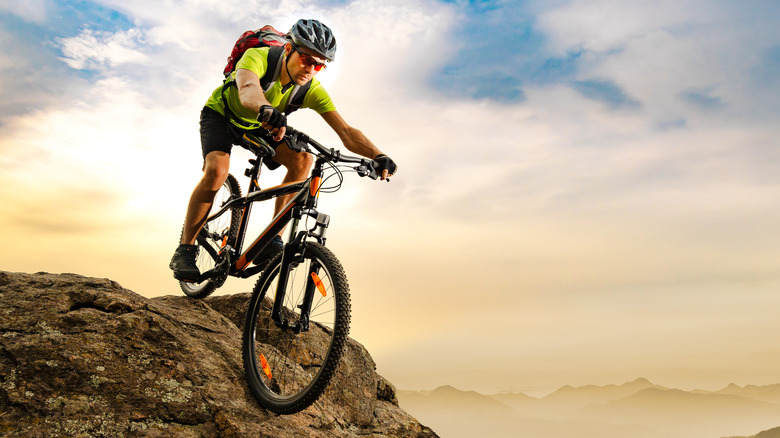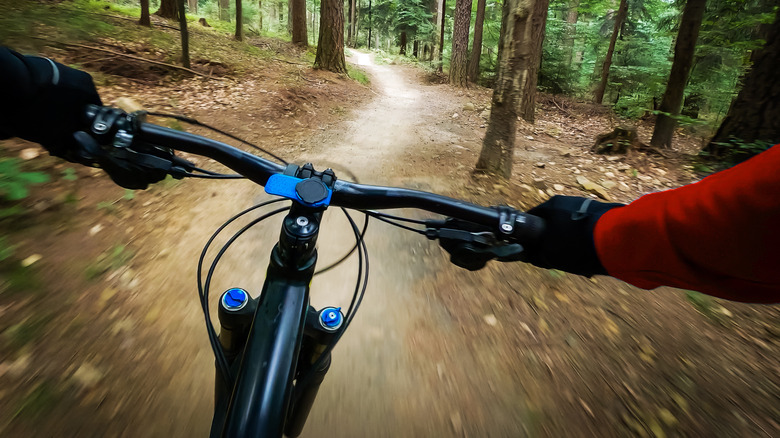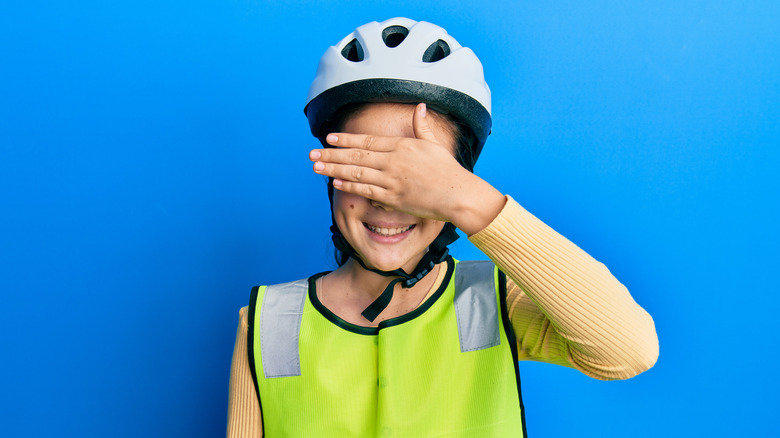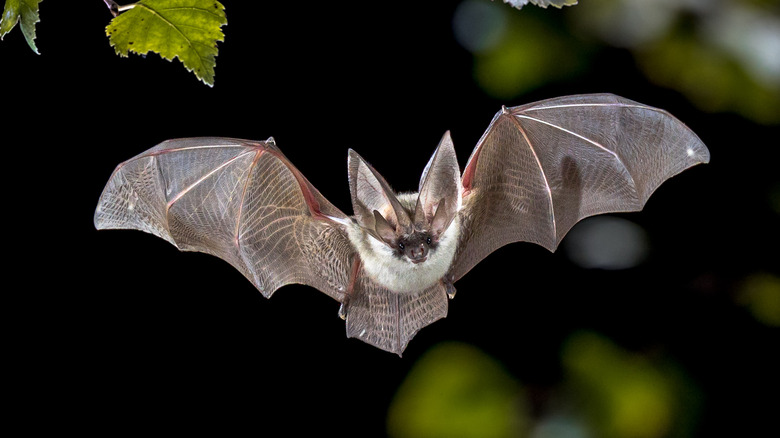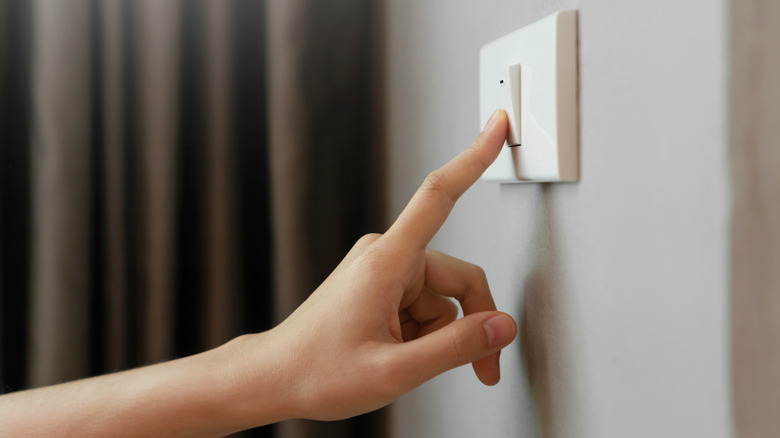The Incredible Story Of The World's Best Blind Mountain Biker
"Blind mountain biker." It's a joke, right? Blind or visually-impaired athletes compete in a number of sports, as Sight and Sound makes clear, but most of them are clearly safe: golf, swimming, polybat (a form of table tennis modified for the blind). Even road cycling has a variation that's safe for the blind: tandem biking, where a sighted cyclist pilots, or rides in front, while a blind cyclist stokes, or rides in the back (via Bicycling). But mountain biking?
Mountain biking isn't the most dangerous sport in the world (can you guess what is?), but it has its risks. In cross-country mountain biking, your tires can lose their grip on rock or sand, sending you toppling. In downhill mountain biking, a slow reaction can send you flying headlong into a tree. There are hairpin turns and tree roots and ditches and cactus and wild animals and cars and hikers to look out for. You have to keep your eyes open.
Keep your eyes open...
Well, only figuratively. There are a number of blind people who regularly, successfully, get out on the trails. Xavier Hopkins, from Reading, England, only has about 10% vision — everything appears to him like a blurry, extremely overexposed photo, like the image above. (That's a photograph of some fruit, if you were wondering.)
Hopkins' eye problems stem from his albinism. His eyes let in too much light. He also has no depth perception, and what little he sees shakes uncontrollably. His disability has caused him no end of trouble; after university, he struggled to find a job that accommodated his limited vision. But incredible as it may seem, Hopkins not only learned the downhill MTB, as a BBC mini-documentary shows — he even turned professional in 2020, with no fewer than eight sponsors. (He also has an Instagram page.)
Unlike cross-country mountain biking, where riders go over trails and badlands, downhill MTB is more like downhill skiing. The bikes are heavy, with full suspension, and racers in heavy protective gear hurdle down single-track trails as fast as they can, generally without needing to pedal. Mountain Bikes Ride cautions that "this sport can be dangerous if not prepared."
Brian Bushway
But there are stranger cases than Hopkins'. Some blind people, like motivational speaker Brian Bushway, have taken to their bikes by utilizing a unique system: echolocation.
Bushway, according to National Geographic, lost his vision at age 14 to a disease that caused his optic nerves to waste away. On learning that bats, dolphins, and other animals travel through the dark by emitting sounds and judging the distance of nearby objects by the rebounding echo, Bushway began training himself to do the same thing. He would make clicking noises with his tongue against the roof of his mouth. To his surprise, the echo of the click sounded different when he was close to a big object than when he was far away. Slowly, through intense concentration, he began to learn the art of judging distance by clicking.
Today, Bushway rides his bike on trails, paying attention to echoes to judge upcoming objects. It's a dangerous hobby, but Bushway has since become a motivational speaker as well as a hobby biker; the hobby has served the job admirably.
Daniel Kish
Daniel Kish is another echolocater, and a friend of Bushway. In fact, the two men are members of a mountain biking club called Team Bat near Mission Viejo, California, according to Psychology Today.
Completely blind since early childhood, Kish told Smithsonian Magazine that his sonar system is like "an acoustic flashlight," and that echolocation allows him to "see" in flashes. Imagine standing in a pitch-black room, unable to see your own hands. Now imagine the lights flash on, just for a fraction of a second. You can get a decent sense of the room you're in — whether there's furniture, how high the ceiling is. That, says Kish, is more or less how he "sees."
Kish's abilities are prodigious. Just by clicking his tongue, he can perceive, within a 60 degree cone of space (the point of the cone being his mouth) the difference between hedges and fences, the height of walls, where sidewalks start and end, and the form of objects around him. Even wilder, Kish learned all of this on his own. "I taught myself ... in much the same way that you taught yourself how to see."
A rare gift
Bushway and other blind people who have learned to echolocate can discern an incredible degree of texture from the echoes of their clicks. They can tell moving objects from stationary, big ones from small, even hard ones from soft ones. Blind people likely have an advantage over the sighted, as their hearing is generally sharper.
Scientists are beginning to quantify this natural sonar system through MRI scans. According to National Geographic, the calcarine cortex of the brain — the part that normally processes sight — lights up in Daniel Kish when he hears echoes. At a neurological level, he and people like him can "see" echoes (but not other sounds). But not everyone has this ability. In other test subjects, the same recordings stimulated the auditory cortex, or the part of the brain that controls hearing.
Can echolocation be taught, then? Kish teaches other blind people, so it's not entirely off the table. But both of those men have "diverted a part of their brain." It's likely that the ability to see, and the ability to "see" echoes, cannot coexist in one brain. You either have one or the other.
Try it at home!
You may not have the prodigious sonar abilities of Kish or Bushway, but you can try echolocation for yourself at home. Teach Engineering has a lesson plan for schoolteachers introducing their students to echolocation that involves this experiment. You'll need a partner. Turn out the lights, or put on a blindfold (or have your partner put one on). Walk away from each other quietly, so as not to reveal where you went. If only one partner is blindfolded, the other should snap or make a similar noise. It should be fairly easy to locate the sound.
Next, try to walk around the room without seeing. Snap your fingers, click your tongue, or clap your hands, and pay attention to the echo. You may find that you can identify how far you are from a wall or piece of furniture just from the echo you hear. But please — if you try it on a bike, be very, very careful.
